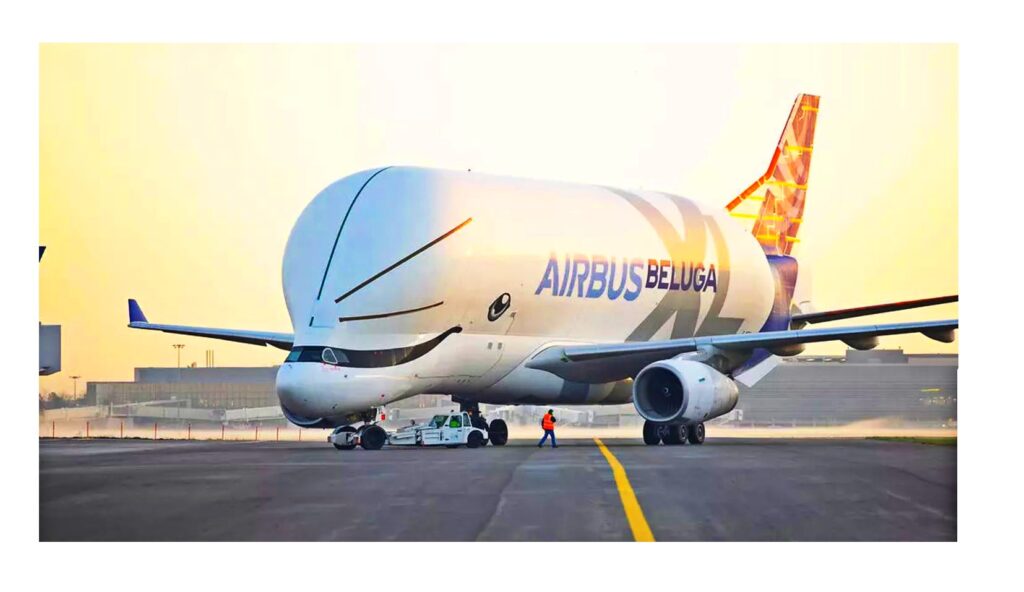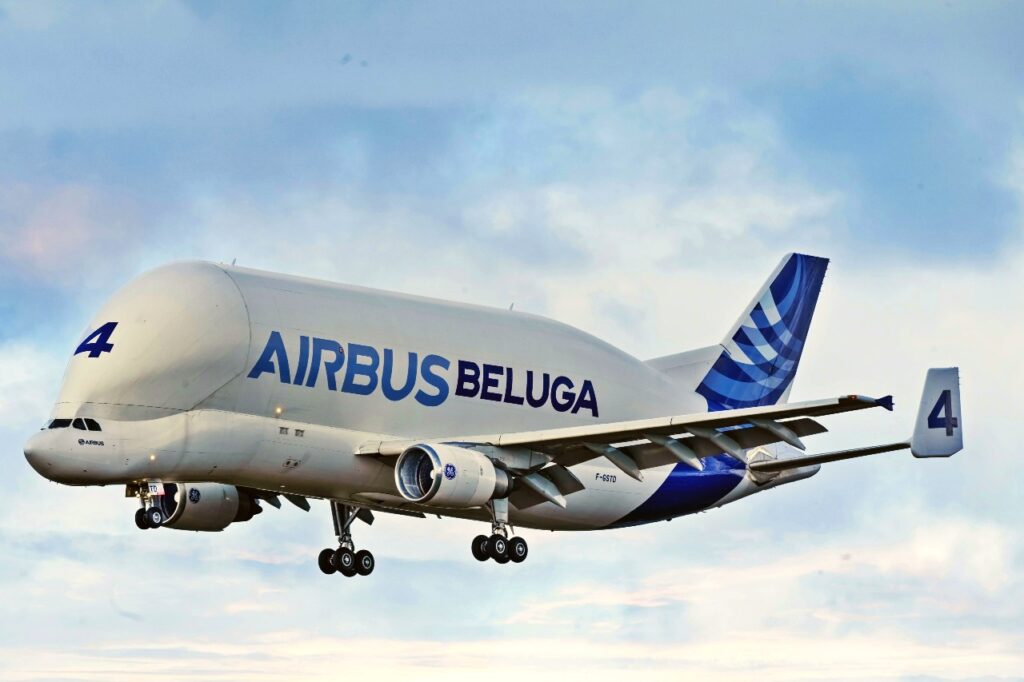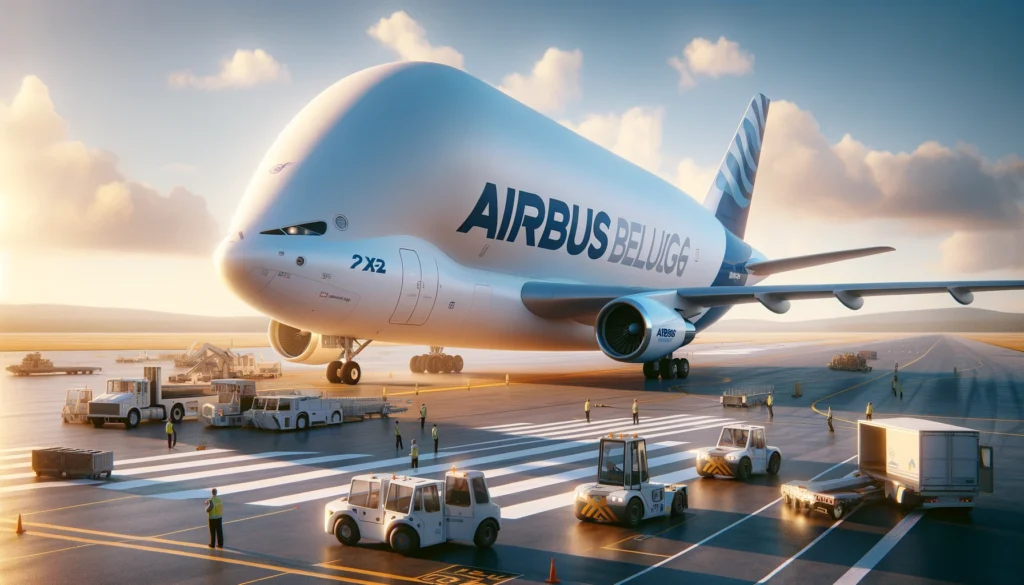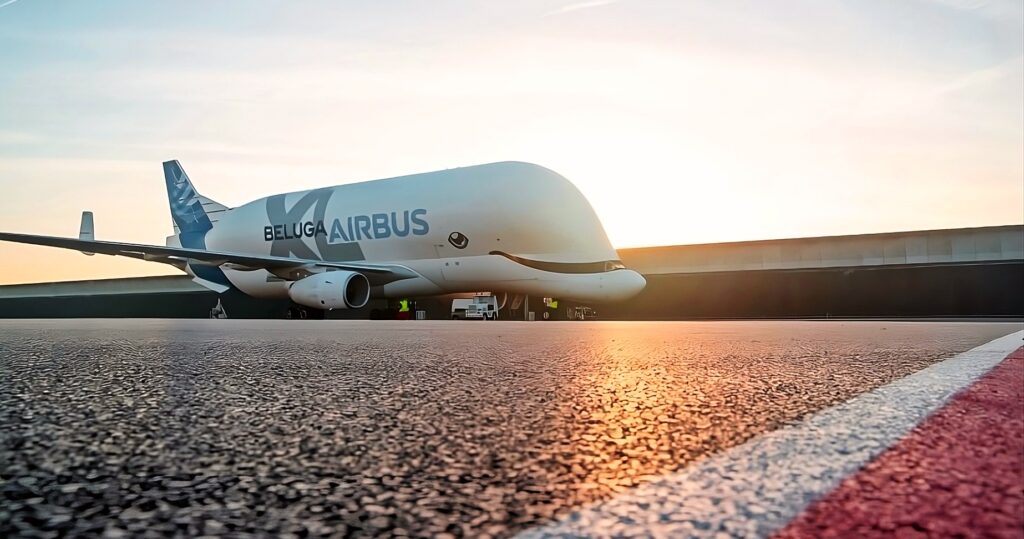The Airbus Beluga XL can be viewed as a giant leap in the field of aviation logistics by the developers of this aircraft, as that was the perfect Design to get an effective means of transport for huge aircraft components for Airbus. Airbus Beluga XL built on the legacy of its predecessor, the first-generation Airbus Beluga. Still, it offers much more than its first model by providing greater capacity and utilizing state-of-the-art aerospace technologies.
Development & Design Philosophy of Airbus Beluga XL:
Furthermore, the Creation of the Beluga XL from a concept to reality has proven that Airbus has the industry’s foresight to solve logistical blockades. Moreover, a combination of technical innovation and the most advanced design resulted in an aircraft that solves the present logistical problems for Airbus and is a classic example of large cargo transportation. Let’s discuss some of its essential feathers.
Airbus Beluga XL Operational Excellence
Cargo Transportation:
Concerning oversized cargo shipment, the Beluga XL is a shining star, enabling the movement of substantial aircraft components such as wings and fuselage between manufacturing sites. It is a critical function for the smooth operation of Airbus’s production lines and helps manage its global supply chain.
Efficiency and Logistics:
In the operational sense, the Beluga XL offers impressive logistics advantages, starting with shortened transportation times and resulting in cost savings in the assembly and delivery processes. Its utilization shows the strategic control of supply chain management and on-time delivery of Airbus planes to customers worldwide.
Airbus Beluga XL Economic Implications:

Investment and Manufacturing Costs:
Furthermore, Constructing the Beluga XL means a significant financial challenge for the Airbus company, with cost components reflecting a high-spec design and the use of advanced technologies. Moreover, This investment demonstrates this commitment to remain at the leading edge in the aviation market. However, Beluga XL’s total cost was around 330 Million dollars, and this total Airbus Beluga program cost around 1 billion dollars to Airbus.
Operating Expenses and Pocket-Friendly Benefits:
Similarly, The operational costs of the Beluga XL, comprising fuel, maintenance, and crew training, are high. However, the service provides an unparalleled strategic benefit through reduced production time and conservation in the supply chain. The Beluga XL shows again that it is possible to invest strategically in innovation, which can eventually provide long-term financial benefits.
Airbus Beluga XL Technical Specifications
Physical Dimensions:
Additionally, Beyond, the most highlighted feature of Beluga XL’s design is its impressive size: a 63.1-meter long body, a 60.3-meter wing span, and an 18.9-meter height. Moreover, These huge physical dimensions make the Airbus Beluga XL one of the largest cargo aircraft in the world. Beluga XL’s Physical structure is an excellent example of modern advancement in technology, as with time, shipment size is expertly increasing, and we can’t rely on sea transport as they are time-consuming. Beluga XL transports oversized shipments that are often beyond the capacity of conventional planes.
Engine Specs and Performance:
The Airbus Beluga XL is equipped with two Rolls-Royce Trent 700 engines to achieve a maximum speed of 737 km/h, with a good range that makes Beluga XL easy to integrate into the Airbus European logistics system. Its engine calibration is for both the fuel economy and the mega power required to lift heavy loads. Still, beyond this, Airbus Beluga XL operational costs are exceptionally high, which aligns with the environmental impact.
Capacity and Load:
The Airbus Beluga XL cargo bay is also quite huge. It offers almost 30% more capacity than its first model, with a width of 7.1 meters and a height of 6.7 meters, ideally encompassing the essence of the Beluga XL’s custom-built nature. Moreover, with a payload capacity of up to 53 tons and the possibility of transporting large sections of Airbus planes, its design will deliver the most space utilization without compromising aerodynamics.
| Feature | Details |
| Aircraft Type | Airbus Beluga XL |
| Length | 63.1 meters |
| Wingspan | 60.3 meters |
| Height | 18.9 meters |
| Maximum Takeoff Weight | 227,000 kilograms |
| Cargo Bay Dimensions | Width: 7.1 meters, Height: 6.7 meters |
| Payload Capacity | Approximately 51 tons |
| Engine Type | 2 x Rolls-Royce Trent 700 |
| Cruising Speed | 737 km/h |
| Range | 4,000 km with maximum payload |
| Operational Role | Transport of oversized aircraft components (e.g., wings, fuselage sections) |
| Development Context | Designed to improve logistics within Airbus’s manufacturing and assembly network |
| Manufacturing Sites | Components sourced from across Europe, with final assembly in Toulouse, France |
| Operational Costs | Includes fuel, maintenance, and crew training; specifics are proprietary but considered strategic |
| Economic Impact | Enhances production efficiency, reduces assembly and delivery times, contributes to Airbus’s global competitiveness |
| Global Logistics Impact | Represents a significant advancement in aviation logistics, setting new standards for the transportation of oversized cargo |

Airbus Beluga XL Future Passenger Configuration :
Embarking on a road of creative exploration going beyond what Beluga XL initially planned, in the upcoming era, the Beluga XL could be utilized as a passenger aircraft and uncovers a myriad of configurational options that provide luxury and comfort. The following tables outline a passenger service delivery plan highlighting the First Class, Business Class, Premium Economy, and Economy Class service levels, all with top customer service in mind.
| Class | Seat Width | Seat Pitch | Seats per Row | Total Seats | Cross-sectional Area for Seats | Seat Structures and Consoles | Additional Features |
| First Class | 40” | 82” | 1-1 | 8 | 350 in² | Four units, 90 in² | Personal minibar, 32” screen, fully flat beds, privacy partitions |
| Business Class | 24” | 78” | 2-2-2 | 60 | 315 in² | Six units, 75 in² | 18” screen, angled lie-flat beds, ample legroom, dedicated service |
| Premium Economy | 20” | 38” | 2-4-2 | 96 | 270 in² | Eight units, 64 in² | Enhanced legroom, 12” screen, priority boarding, upgraded meal service |
| Economy Class | 18” | 32” | 3-4-3 | 180 | 225 in² | Ten units, 45 in² | Standard legroom, 9” screen, standard meal service |

Some Commonly Asked Questions about Airbus Beluga XL:
How many Airbus BelugaXL are there?
According to the last reports, Airbus had built six BelugaXL aircraft to replace the old BelugaST models. Airbus has introduced the BelugaXL, an upgraded A330-200 Freighter that forms part of the fleet growth strategy to cater to the increasing transport needs of bulky aircraft components between Airbus sites and Airbus’ customers.
What has the Airbus BelugaXL passenger capacity?
The Airbus BelugaXL generally aims for freight transportation, such as bulky goods that a regular cargo plane couldn’t transport. No layout for passengers is available in this Airbus BelugaXL design. Nevertheless, there is a small cabin for the crew and the essential personnel, as BelugaXL design is not for a standard of commercial services for passengers.
Is there any Airbus BelugaXL crash case?
To date, no traffic collision has occurred with the Airbus BelugaXL. The BelugaXL program, in its effort to ensure safety and reliability, conquered all stages, design, testing, and operational protocols.
Where was the first Belluga XL flight?
The first flight of the Airbus BelugaXL flew on the 19th of July, 2018, which set a landmark for Airbus, allowing them to start its operational services.
Why is Airbus BelugaXL Famous?
The BelugaXL is famous because its design looks the same as that of a beluga whale, from which it gets its renowned name Beluga XL. That whale-like shape is not only for beauty; the bulged front and the larger cargo body are necessary to fit large items like aircraft wings and fuselage sections.
What do BelugaXL and BelugaST airplanes have in common, and what are the differences between BelugaXL and BelugaST?
The BelugaXL is more sophisticated than the older BelugaST, with a capacity of carrying 30% more freight. It can carry simultaneously two A350 XWB wings, which the BelugaST does not. BelugaST only being able to transport one wing at a time. Airbus BelugaXL is derived from the more spacious cabin of the A330, while the ST is a modified version of the A300.
What are the key specs of the BelugaXL?
The BelugaXL has a maximum freight capacity of around 51t and has travel distances up to 4,000 km. Its monster cargo bay, about 23 feet wide, 26 feet tall, and 148 feet long, holds one of the biggest cargo capacity aircraft ever built.
Can people, as the public, take a flight on Beluga XL?
No, the Airbus BelugaXL does not have a commercial certification for passenger operations. Its function is logistics, assisting Airbus’s production line by shipping huge aircraft components that can’t carried out by other air cargo planes.
How does the BelugaXL contribute to Airbus operations?
The BelugaXL provides a service for Airbus by ensuring smooth and quick shipping of large aircraft parts among its different industry locations across Europe. Such flexibility ensures mass production schedules and plays an essential part in the global aerospace supply chain.
Airbus Beluga XL Complete Fleet Table:
| MSN # | Registration | Type | First Flight Date | Delivery Date | Fleet # | Capacity (Tonnes) | Operational Role | Remarkable Features |
| 655 | F-GSTA | Airbus A300-605 ST | 13 Sept 1994 | 25 Oct 1995 | 1 | 47 | Europe-wide logistics | First oversized air transport for Airbus components. |
| 751 | F-GSTB | Airbus A300-605 ST | 26 Mar 1996 | 24 Apr 1996 | 2 | 47 | Component transport | Enhanced avionics for improved navigation. |
| 765 | F-GSTC | Airbus A300-605 ST | 21 Apr 1997 | 07 May 1997 | 3 | 47 | Oversized cargo delivery | Upgraded cargo handling system. |
| 776 | F-GSTD | Airbus A300-605 ST | 09 Jun 1998 | 18 Dec 1998 | 4 | 47 | Inter-facility component transfer | Tailored for large, non-standard payloads. |
| 796 | F-GSTF | Airbus A300-605 ST | 12 Dec 2000 | 05 Jan 2001 | 5 | 47 | Special cargo operations | Last of the original BelugaST models, with refined aerodynamics. |
| 1824 | F-GXLG | Airbus A330-743L XL | 19 July 2018 | 19 July 2018 | XL1 | 53 | Increased capacity transport | First of the new generation, for A350 and other large parts. |
| 1853 | F-GXLH | Airbus A330-743L XL | 15 Apr 2019 | 06 Dec 2019 | XL2 | 53 | High-volume component logistics | A larger cargo hold and enhanced range. |
| 1930 | F-GXLI | Airbus A330-743L XL | 02 July 2020 | 26 Oct 2020 | XL3 | 53 | Oversized equipment transport | advanced avionics and flight systems. |
| 1985 | F-GXLJ | Airbus A330-743L XL | 20 Jul 2021 | 04 Oct 2021 | XL4 | 53 | Global logistics support | Enhanced fuel efficiency and environmental performance. |
| 2027 | F-GXLN | Airbus A330-743L XL | 21 Jul 2022 | 26 Sep 2022 | XL5 | 53 | Intercontinental component delivery | Tailored for long-haul, high-capacity transport tasks. |
| 2041 | F-GXLO | Airbus A330-743L XL | 21 Jul 2023 | 24 Nov 2023 | XL6 | 53 | Flexible cargo solutions | The latest addition symbolizes the peak of BelugaXL’s capabilities. |
B-58 Hustler: Discover the Beast That Changed History Now!

